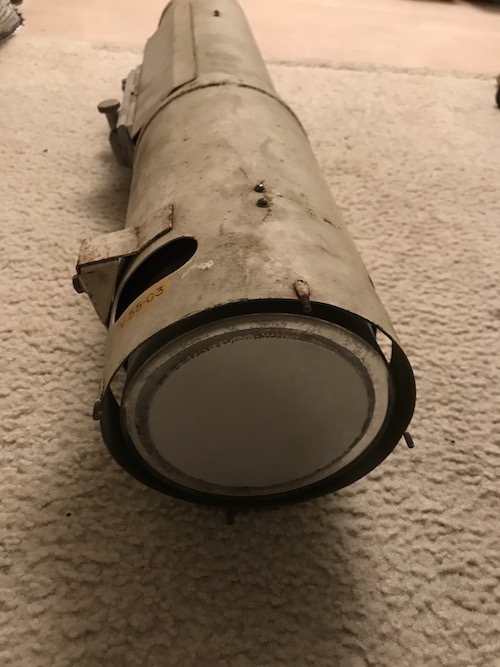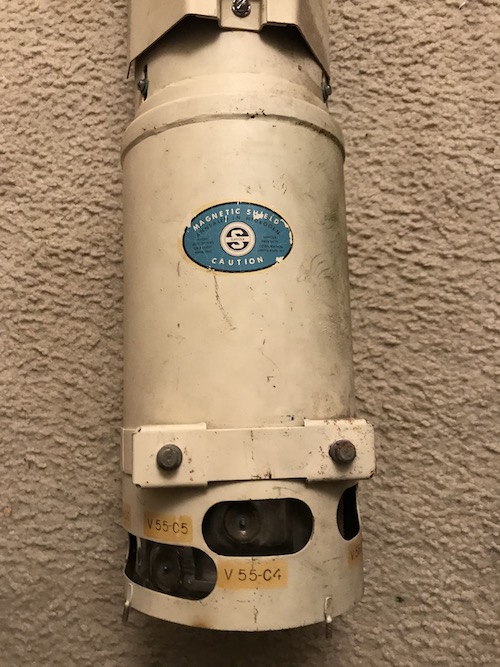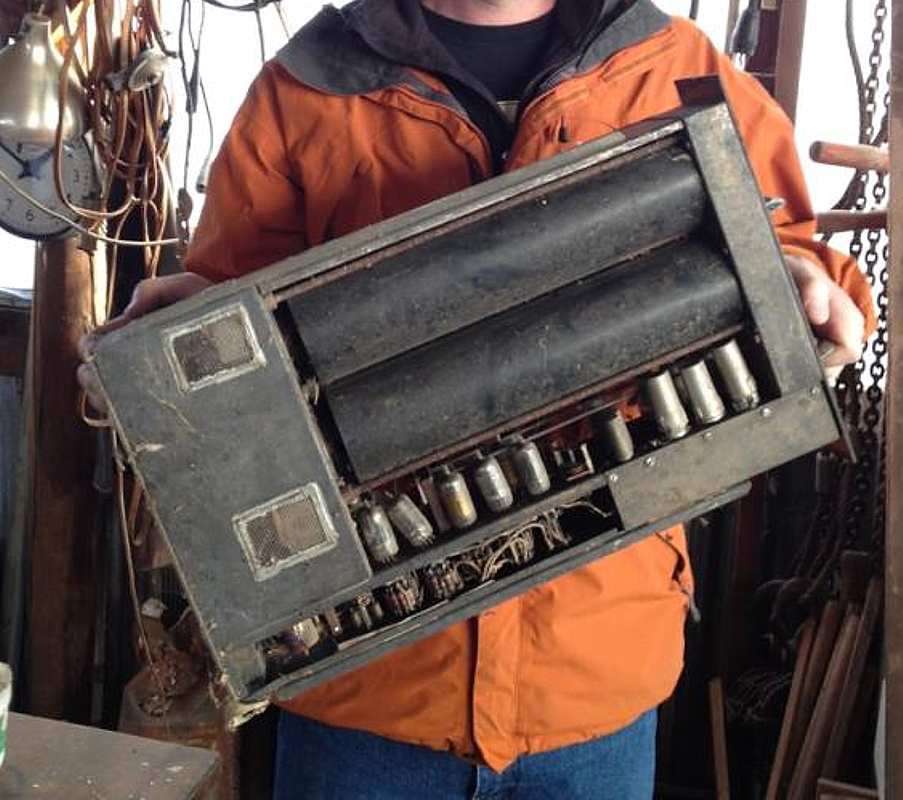Hi All,
I am new to this forum!
I recently went to a private sale and I bought a lot of equipment presumed to be related to building lasers.
After paying up and bringing them home I realized that this part is not a laser part but rather a digital display made by IBM . I did some research and it looks quite similar to the Williams tube. It looks to definitely be a Cathode Ray Tube. Any ideas?
IMG_3427 2|374x499
An interesting find. Certainly a cathode ray tube. I would think not a Williams-type storage device, because they don’t need to expose the ‘display’ and in fact it’s helpful to cover it. So, I’d imagine it’s part of a 'scope or other diagnostic tool, or possibly part of some kind of visual output like a film printer, microfilm printer, or just possibly a projection display.
Are there any other labels? What makes you think it’s IBM? The diameter of the display area might be a useful clue, although I think this will be difficult to track down without a part number.
Mind that there are some latches at the front edge as for attaching something to it or attaching this to some other contraption. I wouldn’t rule out the Williams tube. (You certainly want to have access to the scope for maintenance and any front part may be just missing.)
There are also some ports at the front labeled C4, C5, etc.
Here’s an interesting page about William tubes for comparison:
(I like that early screen art depicting a giraffe.)
And another one, showing just the bare tube of a IBM-85 Willams memory tube in detail:
http://lampes-et-tubes.info/sc/sc044.php?l=e
(I guess, there was nothing too special about the tubes, separating them from other use cases.)
Finally, here’s an image of the assembly in a 706 storage unit as used in the IBM 701 (from Documents, Links & Videos):
See also this entry in the CHM catalog: Type 706 Williams-Kilburn Tube Electrostatic Memory | X1284.96 | Computer History Museum
(Personally, I’d say, the form factor may fit, but not enough evidence to confirm this either.)
Oh well noted! It might then, yet, be a storage tube!
However, there are none of those ports near the front plate on the IBM-85 Williams tube, but it may be another model. Still no significant evidence this way or another.
Update,
I looked a little closer and found another tag. I was astonished to find you what it really was.
@EdS You were ,in a way, right. But in reality it had multiple functions. It’s called an IBM Typotron a cousin of the Charactron. It was part of the cold war era Program, IBM SAGE Semi-Automatic Ground Environment. It had system of large computers and associated networking equipment that coordinated data from many radar sites and processed it to produce a single unified image of the airspace over a wide area. The actual typotron , was announced and developed circa 1956, combined the character generator method of the Charactron with a storage-tube screen structure. The result was a display that required no further use of computer memory – very expensive at that time – once the information was written on the storage target until one desired to change the displayed information. In all other respects operation was similar to that of a conventional storage tube. From my research there is only a handful in existence as this was quite the achievement at the time.
Oh, that’s splendid! A melding of the memotron and charactron, according to this nice document (from Lamps & Tubes).
Very nice! And thank you @EdS for digging up the document!
(As I understand it, there was no means of deselecting a single character, you could only wipe the entire screen at once?)
BTW, has anyone an idea, how the light gun on the Charactron worked? With a usual light pen, you may discern the activated spot by a timing function respective to the last plot command or a known raster sweep. However, memory displays like these were refreshed uniformly by a flood gun. (So there’s no newly plotted x/y dot or raster scan and by this no correlation between activation intensity and a known refresh location). How do you work out which spot is under the light gun sensor (photomultiplier)?
Update: My fault, the Charactron was still a x/y display as we know it with a few complications for character display. This issue would have only applied to this Typotron tube. (I guess, this may have hindered any further pursuit of this technology as suggested in the Typotron document.)
I think that’s an easy one: the Charactron is a dynamic (sequential, refreshed) display, not a storage display - unlike the Memotron and Typotron!
Yes, it just appeared to me after writing, see the update.
I guess, this issue was a severe limitation, since interactive displays would have been what you wanted for applications like radar mapping as suggested by the document, you linked above. Still an interesting technology, which could have potentially solved many of the issues of early graphics displays.
Just going to sit here and marvel about the age when appending tron to everything made it high tech and all advanced.
Typotron
Charactron
Toastron
Eggstron
I was going to suggest emailing the Living Computer Museum where Curious Marc volunteers if you didn’t have any luck finding out what that thing was. They have lots of old-timer IBM types volunteering there.
What a fascinating find.
(About the -tron naming: you led me down a bit of a rabbit hole @whartung. I think it goes back to the Cyclotron “named as laboratory slang” although it’s possible the Pelletron or the Laddertron were earlier, and we’re back in the 1930s if not the 20s. All of them are particle accelerators: as is a CRT! So calling any CRT a -tron is consistent with that coinage. Although I still don’t know where it comes from, we do know the electron - a convenient particle to accerate - was named in 1891.
Inspired by a paper from Norwegian engineer Rolf Wideroe, Lawrence invented a unique circular particle accelerator, which he referred to as his “proton merry-go-round,” but which became better known as the cyclotron . The first cyclotron was a pie-shaped concoction of glass, sealing wax, and bronze.
)
Don’t forget the Minskytron! ![]()
(The Minskytron and Other Early Graphics Demos @ PDP-1)
“tron” was the In suffix of the early 1960s
(Martin Graetz in “Origin of Spacewar” – we may add, and the late 1950s as well.)
The Living Computer Museum and/or the Computer History Museum (CHM) may be still interested in documenting it. (Ken Shirriff may be another contact, esp. for the CHM.)
Oh, ya know, I always get those two museums mixed up. ONE of them is the one where Ken and Marc volunteer.
Yes, I will reach out to them. What do you believe is the rarity or worth of a piece like this? After all it’s quite fragile so I want to keep it safe. Is this a piece that would be considered museum worthy?
Regarding the first question, I do think it’s quite rare and worth preserving (but I am by no means an expert).
Regarding museums, especially the big ones, and exhibits, I honestly don’t know. They have already much more than they can show in exhibition. So it comes down to “telling a story” (compare what the CHM is doing) and if it fits any of these stories, especially those already told. (In museum terms: story = exhibition space, which is limited.)
Personally, I’m convinced that the CHM should tell the story of computer displays and visual computing as one of their main stories, but I’m not seeing much of it. (I even once suggested this to Dag Spicer, the CHM’s senior curator, some years ago, when I was honored by an email exchange with him. Also, I want there to be a coffee table book titled “Glass” on the subject, quite like “Core Memory” – have Mark Richards all over the CHM making glorious photos of obscure and impressive display technology.)
So, while any computer museum of worth should be definitely interested, honestly, I’m not sure if it would be ever seen in an exhibition. They will be happy to accept it as a donation to put it in their catalog, but otherwise, I’m not sure.
But museums are also institutions for documentation. They should know that a rare device is still around and where it is to be found. At least in my opinion, they should be happy to get professional grade photos (including a visual scale for reference) for documentation and to archive them in their catalogs. (Any hardware transactions may still be covered in your will. ![]() )
)
But this is just my musing, any informal contact is better than that to find out more.
Edit: I guess, the guys around Ed Thelen (http://ed-thelen.org) may be interested in any photos, as they are documenting all kind of IBM related technology. I believe, Marc Verdiell, AKA CuriousMarc, has some connections to them (the IBM 1401 restoration team), as well. Ed Thelen is also accessible via email.


